The ASUS Maximus VIII Impact Z170 ROG Mini-ITX Motherboard Review
by Ian Cutress on December 29, 2015 9:00 AM ESTSystem Performance
Not all motherboards are created equal. On the face of it, they should all perform the same and differ only in the functionality they provide - however this is not the case. The obvious pointers are power consumption, but also the ability for the manufacturer to optimize USB speed, audio quality (based on audio codec), POST time and latency. This can come down to manufacturing process and prowess, so these are tested.
Power Consumption
Power consumption was tested on the system while in a single MSI GTX 770 Lightning GPU configuration with a wall meter connected to the OCZ 1250W power supply. This power supply is Gold rated, and as I am in the UK on a 230-240 V supply, leads to ~75% efficiency > 50W, and 90%+ efficiency at 250W, suitable for both idle and multi-GPU loading. This method of power reading allows us to compare the power management of the UEFI and the board to supply components with power under load, and includes typical PSU losses due to efficiency. These are the real world values that consumers may expect from a typical system (minus the monitor) using this motherboard.
While this method for power measurement may not be ideal, and you feel these numbers are not representative due to the high wattage power supply being used (we use the same PSU to remain consistent over a series of reviews, and the fact that some boards on our test bed get tested with three or four high powered GPUs), the important point to take away is the relationship between the numbers. These boards are all under the same conditions, and thus the differences between them should be easy to spot.
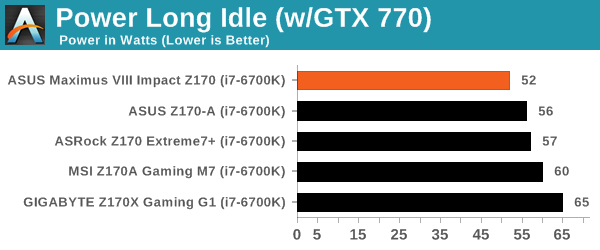
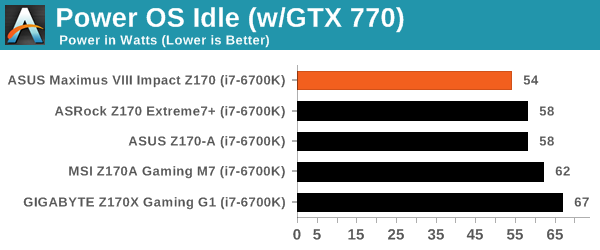
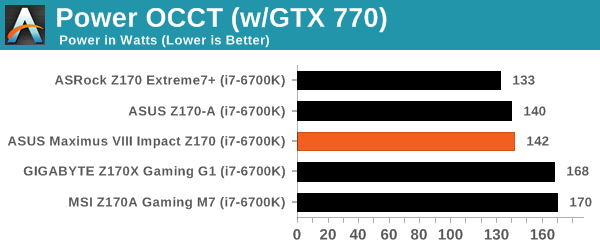
The Impact uses MultiCore Turbo, which typically increases the voltage at load to ensure a consistent top multiplier no matter what the loading is. The result of this increased performance is typically increased power consumption, and we’ve seen motherboards cause the i7-6700K CPU to consume 76W (from idle to OCCT load) up to 110W. With the Impact, perhaps due to its size, makes that delta only 90W, which isn’t as good as the non-MCT motherboards, but it currently the best MCT motherboard for power draw we’ve tested.
Non UEFI POST Time
Different motherboards have different POST sequences before an operating system is initialized. A lot of this is dependent on the board itself, and POST boot time is determined by the controllers on board (and the sequence of how those extras are organized). As part of our testing, we look at the POST Boot Time using a stopwatch. This is the time from pressing the ON button on the computer to when Windows 7 starts loading. (We discount Windows loading as it is highly variable given Windows specific features.)
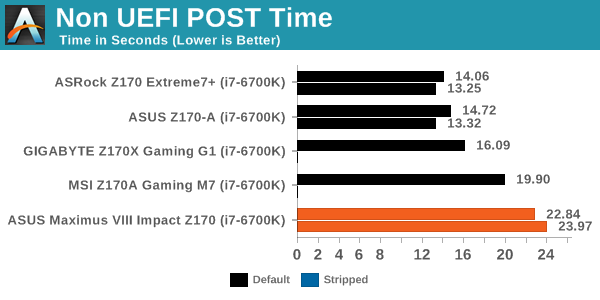
Anything over 20 seconds for a mainstream motherboard is usually seen as odd, which is why question marks come over the Impact sitting at 22 seconds when the Maximus VIII Extreme (which is being tested) only needs 16.50 seconds.
Rightmark Audio Analyzer 6.2.5
Rightmark:AA indicates how well the sound system is built and isolated from electrical interference (either internally or externally). For this test we connect the Line Out to the Line In using a short six inch 3.5mm to 3.5mm high-quality jack, turn the OS speaker volume to 100%, and run the Rightmark default test suite at 192 kHz, 24-bit. The OS is tuned to 192 kHz/24-bit input and output, and the Line-In volume is adjusted until we have the best RMAA value in the mini-pretest. We look specifically at the Dynamic Range of the audio codec used on board, as well as the Total Harmonic Distortion + Noise.
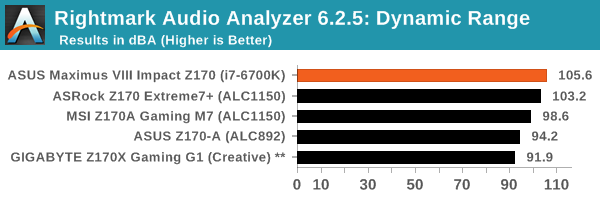
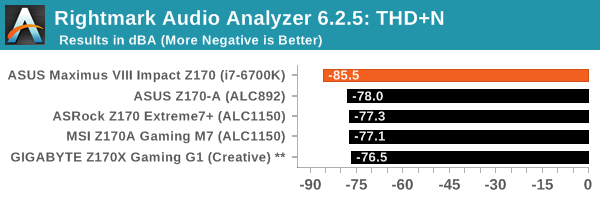
ASUS’ audio results in our test keep hitting high notes (pun intended), and the Impact is no different with a good SNR but also great distortion numbers.
USB Backup
For this benchmark, we transfer a set size of files from the SSD to the USB drive using DiskBench, which monitors the time taken to transfer. The files transferred are a 1.52 GB set of 2867 files across 320 folders – 95% of these files are small typical website files, and the rest (90% of the size) are small 30 second HD videos. In an update to pre-Z87 testing, we also run MaxCPU to load up one of the threads during the test which improves general performance up to 15% by causing all the internal pathways to run at full speed.
Due to the introduction of USB 3.1, as of June 2015 we are adjusting our test to use a dual mSATA USB 3.1 Type-C device which should be capable of saturating both USB 3.0 and USB 3.1 connections. We still use the same data set as before, but now use the new device. Results are shown as seconds taken to complete the data transfer.
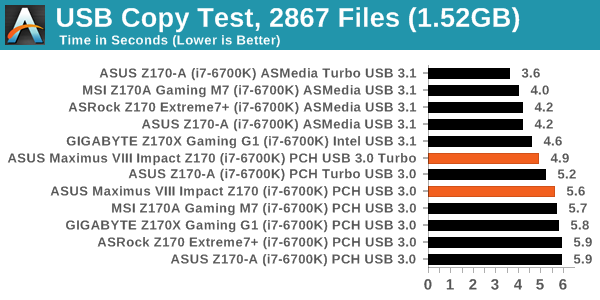
The USB 3.0 performance for the Impact was good to take top spot in our non-Turbo testing, but we had issues on the Impact testing the Alpine Ridge controller in USB 3.1 mode, as well as either mode using the Boost software. The test would end quickly, but say all the data is transferred and yet the drive is still working, showing that reporting the complete transfer is happening before the data is committed. Thus always make sure the drive is finished before removing! It also means we can’t run our tests properly.
DPC Latency
Deferred Procedure Call latency is a way in which Windows handles interrupt servicing. In order to wait for a processor to acknowledge the request, the system will queue all interrupt requests by priority. Critical interrupts will be handled as soon as possible, whereas lesser priority requests such as audio will be further down the line. If the audio device requires data, it will have to wait until the request is processed before the buffer is filled.
If the device drivers of higher priority components in a system are poorly implemented, this can cause delays in request scheduling and process time. This can lead to an empty audio buffer and characteristic audible pauses, pops and clicks. The DPC latency checker measures how much time is taken processing DPCs from driver invocation. The lower the value will result in better audio transfer at smaller buffer sizes. Results are measured in microseconds.

ASUS has been on a recent march towards low DPC numbers, and the Impact scores under 50 microseconds, making it one of our best ever results. The victory is short lived however, as we’re currently testing the Maximus VIII Extreme, and that scored under 25.










42 Comments
View All Comments
jasonelmore - Wednesday, December 30, 2015 - link
take out the sound card then, and install a high end xonar one. it's removable.edzieba - Tuesday, December 29, 2015 - link
m.2 is the glaring omission here for an ITX board. SFF PC's (the whole point of ITX) benefit more from m.2 than u.2, and m.2 to u.2 adapter boards are readily available. u.2 to m.2 adapters are not currently available (or even announced), and would introduce cable spaghetti due to the need for a power injector along with the actual adapter.Great_Scott - Tuesday, December 29, 2015 - link
While an M.2 slot is a great idea and a strange omission, the sound solution is more glaring.WTH is a RealTek solution being used here? Given the price of the board, a XONAR-branded solution makes a lot more sense.
Vatharian - Wednesday, December 30, 2015 - link
Xonar is a C-Media rebrand. Still I'd like it more. Or IDT+decent Wolfsons...Flunk - Tuesday, December 29, 2015 - link
Missing M.2 does make this less attractive than some of the other offerings on the market. This is a surprising omission considering the Maximus VII Impact has one. I may be in the minority, but I can't see a reason for the onboard Wi-Fi, if you're building a high-priced gaming machine wired ethernet is a requirement. The LED and buttons on the back are pretty useless too. If you're running without a case they could be anywhere on the board and if you're running with a case you don't need the buttons.ciparis - Tuesday, January 12, 2016 - link
"if you're building a high-priced gaming machine wired ethernet is a requirement."An expensive gaming machine that lives in the living room (a big reason for going mini-ITX to begin with) might well have to rely on wifi. A good 802.11ac implementation is no slouch.
DanNeely - Tuesday, December 29, 2015 - link
What's the power output limit for the USB3.1 C port? The new power delivery spec allows up to 5A at 5, 12, or 20V; but I find it unlikely that desktop systems would provide the maximum possible power; so what the port can output needs to be added to the review somewhere. (If for no other reason, the hardware to make 20V power would take up a decent amount of space.)FelixDraconis - Tuesday, December 29, 2015 - link
This is totally not a big deal, as I can still extract useful information from your review.However, I found the text of it to be confusing and riddled with typos and grammatical errors. This seems like a good opportunity for you to improve in the coming year.
All over the place you use the wrong word, as if you're relying on spell check and not reading what you write.
For example:
- The analogy of Senior/Sophomore/Freshman was baffling when applied to motherboards. Is this the age of the motherboard - that somehow a Freshman motherboard is newer (younger)? Or do Senior motherboards have more features? Interlacing this with a bunch of meaningless marketing terms makes it incomprehensible. You could have taken this text out and sorted the 100-Series list directly below by whatever buckets you were considering.
- "Overal, the nature of Skylake makes our CPUs"... What 'nature' of Skylake? You don't specify. So, I have to decipher it and figure you mean 'Skylake as a whole'. This is redundant nonsense. Overall is also redundant. Also, Skylake IS the CPU. Just say 'Skylake gets 4.5 GHz'. Less is better.
- "To read specifically about the Z170 chip/platform and the specifications therein, our deep dive into what it is can be found at this link." - This isn't wrong, but is so flowery that it feels like you're padding out the words. Just say "To read more about the Z170 chipset, our deep dive is here." (If you really want to say link, I understand, but most of the rest are junk words that confuse.) Also, the Z170 is the chipset. Not the chip or the platform.
- "The overclocking methodology from ASUS comes in several formats." - I know what you're trying to say, but this is awkward. It's as if someone was running directly through google translate.
- "For manual overclocks, based on the information gathered from previous testing, starts off at a nominal voltage" - Manual overclocks, based on previous testing, start off at a nominal voltage.
I could go on, but that's your job! Hopefully this makes you sit back, go 'whoa', and then feel inspired to go on a studying rampage. :D
Your words, more than anything, indicate to people your value. I mean that outside of reviews. You'll be writing resumes and blogs and who knows what else your whole life. Once you get the writing down, join us at Toastmasters for the public speaking. ;)
okashira - Tuesday, December 29, 2015 - link
Oh please, most of what you point out is a matter of opinion and personal preference only. The wording isn't perfect, but at least he's doing something of value... not toastmasters, ugh.jasonelmore - Tuesday, December 29, 2015 - link
these are tech geeks trying to be writers. Most writers in the tech blog business never obtained a college diploma. Even if they do have one, they probably majored in CIS or some standard business degree.Your right, it would not hurt for them to take a few Comp classes, if they are trying to be leaders in their field.